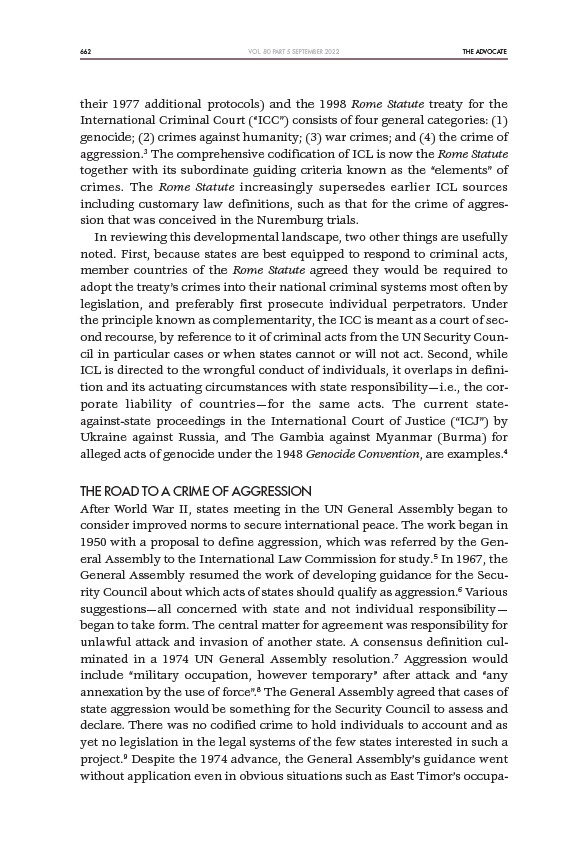
662 THE ADVOCATE
VOL. 80 PART 5 SEPTEMBER 2022
their 1977 additional protocols) and the 1998 Rome Statute treaty for the
International Criminal Court (“ICC”) consists of four general categories: (1)
genocide; (2) crimes against humanity; (3) war crimes; and (4) the crime of
aggression.3 The comprehensive codification of ICL is now the Rome Statute
together with its subordinate guiding criteria known as the “elements” of
crimes. The Rome Statute increasingly supersedes earlier ICL sources
including customary law definitions, such as that for the crime of aggression
that was conceived in the Nuremburg trials.
In reviewing this developmental landscape, two other things are usefully
noted. First, because states are best equipped to respond to criminal acts,
member countries of the Rome Statute agreed they would be required to
adopt the treaty’s crimes into their national criminal systems most often by
legislation, and preferably first prosecute individual perpetrators. Under
the principle known as complementarity, the ICC is meant as a court of second
recourse, by reference to it of criminal acts from the UN Security Council
in particular cases or when states cannot or will not act. Second, while
ICL is directed to the wrongful conduct of individuals, it overlaps in definition
and its actuating circumstances with state responsibility—i.e., the corporate
liability of countries—for the same acts. The current state-
against-state proceedings in the International Court of Justice (“ICJ”) by
Ukraine against Russia, and The Gambia against Myanmar (Burma) for
alleged acts of genocide under the 1948 Genocide Convention, are examples.4
THE ROAD TO A CRIME OF AGGRESSION
After World War II, states meeting in the UN General Assembly began to
consider improved norms to secure international peace. The work began in
1950 with a proposal to define aggression, which was referred by the General
Assembly to the International Law Commission for study.5 In 1967, the
General Assembly resumed the work of developing guidance for the Security
Council about which acts of states should qualify as aggression.6 Various
suggestions—all concerned with state and not individual responsibility—
began to take form. The central matter for agreement was responsibility for
unlawful attack and invasion of another state. A consensus definition culminated
in a 1974 UN General Assembly resolution.7 Aggression would
include “military occupation, however temporary” after attack and “any
annexation by the use of force”.8 The General Assembly agreed that cases of
state aggression would be something for the Security Council to assess and
declare. There was no codified crime to hold individuals to account and as
yet no legislation in the legal systems of the few states interested in such a
project.9 Despite the 1974 advance, the General Assembly’s guidance went
without application even in obvious situations such as East Timor’s occupa-